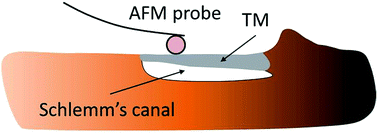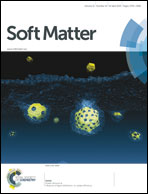Mechanical analysis of rat trabecular meshwork†
Abstract
Stiffness of trabecular meshwork (TM) may play an important role in regulating outflow resistance in healthy and glaucomatous eyes. However, the current techniques for stiffness measurement can only be applied to TM dissected from human donor or large animal eyes. It is a challenge to measure TM stiffness in mouse/rat eyes because of their smaller sizes and the delicate nature of TM dissection. To this end, a new technique was developed to determine the stiffness of rat TM using atomic force microscopy (AFM). In the study, rat eyes were enucleated immediately after death and perfused with a tracer (Evans blue) for 40 min. Then, the anterior segment was dissected and flat-mounted on a Petri dish with TM facing upwards. An AFM probe with a gold-coated colloid tip was used to sequentially indent the corneal, TM, and uveoscleral tissues. Assuming these tissues to be neo-Hookean materials, the indentation data were analyzed with a newly developed mathematical model to calculate the apparent initial Young's moduli (E0)app. The geometric mean & SE of (E0)app were 162 Pa & 1.2 (n = 13) for TM and 6189 Pa & 1.4 (n = 11) for cornea; and the difference was statistically significant (p < 0.01). The technique established in this study allows the use of rat eye as a potential model for investigation of TM stiffness and its influences on outflow resistance. Future studies may also utilize this technique to evaluate mechanisms of TM stiffness change caused by aging, outflow dysfunction, pathogenesis of glaucoma, and drug treatment.


 Please wait while we load your content...
Please wait while we load your content...